INTRODUCTION & LITERATURE REVIEWThe laryngeal manifestations of gastroesophageal reflux are becoming increasingly more reported in our field13,20,27. Recent studies reported it is associated with 25 to 50% of the patients with "globus"32 sensation, with more than 80% of the patients with chronic hoarseness and with 10% to 20% of the patients with chronic cough. 15,16, 21,29
The laryngopharyngeal reflux11,13,14 has peculiar characteristics and shares some similarities with the gastroesophageal reflux, however it has different aspects that range from its pathophysiology to treatment responsiveness1. It happens not only during the night, but during the day as well, in standing position and intermittently. There is an involvement of the superior esophageal sphincter24. In general its manifestations occur through unspecific symptoms such as, hoarseness11,15, dysphagia, "globus" sensation, sialorrhea, dry cough 23and choking.21,24,29.
Less than half of the patients may have gastric and esophagealic complaints and the upper digestive tract may not reveal its existence in up to 50% of the cases.15,10. The efficacy of the initial clinical management should include, besides dietary measures, the use of proton channel blockers 13,17. The response to the clinical management that is properly applied will provide information on whether surgical intervention is needed or not25. The choice for surgery is gaining an increasing number of supporters, due to the favorable outcomes reported, increasing refractoriness to medicine use and the need to use long-term therapy 12,25,26.
Laryngoscopy, associated (if possible) with stroboscopy, is generally the first examination requested by the otorhinolaryngologist. Findings of changes such as hyperemia of the interarytenoidal space or vocal fold injuries such as granulomas; polyps, Reinke's edema, and subglottic stenosis require a more comprehensive diagnostic investigation. The two or three- channel 24-hour pHmetry associated with manometry is the method that presents better sensitivity and specificity5,14,31,32. The associated pathologies such as Zenker's diverticulum and lLarynx carcinoma4,9 cannot be forgotten in the differential diagnosis.
The gastroesophageal reflux with laryngopharyngeal involvement is a common pathology, however it is still under diagnosed16,27. If the specialist has patients with complaints of chronic laryngeal x manifestations that do not improve with conventional therapy, he or she should include the laryngopharyngeal reflux among thehis investigated itemsions.
The early and correct diagnosis will alert the patient and the doctor to middle and long term potential damages 8,11,17,18 and to the need for clinical or surgical treatment, therefore trying to prevent new episodes of laryngitis and even the onset of airways and digestive tract metaplasias and neoplasmias 3,25,26.
2. OBJECTIVES: The current study tries to correlate early clinical and laryngoscopic findings that may be an indication of lLaryngopharyngeal reflux with the pHmetry results associated with 24-hour manometry.
Assess patient's answers to drug therapy and changes in dietary habits.
3. MATERIAL AND METHODs: This is a prospective study that included 61 adult patients (above 18 years old), living in Salvador, Bahia, screened in the clinic by only one doctor, from January/1998 to July/2000. The patients had to have chronic complaints for more than 3 months such as, dry cough, "globus", sialorrhea, dysphonia, throat clearing, halitosis and choking.
After initial screening, patients who had history, physical examination or nasofibroscopy indicating nasosinusdal abnormalities were excluded from the study, as well as hypothyroidism patients and smokers. In a second stage, the participants of the study underwent laryngoscopy. Those with findings of thickening of the interarytenoidal space; hyperemia and/or arytenoid edema; salivary stases in the pyriform sinuses; hyperemia of epiglottis or hypopharynx were kept in the study. Other benign laryngeal x pathologies such as cysts, polyps, Reinke's edema, granulomas and subglottic steanosis were not included.
All patients were subjected to 2-channel 24-hour pH manometry, performed by only one gastroenterologist. Initially, the lower esophageal sphincter was located through computerized esophageal manometry and subsequently two pH sensors were placed as follows: one at 20 cm and the other at 5 cm of the lower esophageal sphincter.
The results of 24-hour pHm manometry and laryngoscopic examination were compared and a joint management decision was made subsequently. The patients with confirmed diagnosis of gastroesophageal reflux began treatment with proton channel blocker drugs (omeprazoleOmeprazole) associated with changes in the dietary habits. Subsequently, two quarterly reassessments were made. They compared the frequency and intensity of early symptoms with the current manifestations. The new endoscopic examination was also considered as an improvement or worsening criterion.
4. RESULTS: The study considered an initial sample of 61 symptomatic patients that met the inclusion criteria, being the youngest patient 26 years old and the eldest 72 years old with mean the average age ranging from 44 to 48 years. There was a predominance of females (35 subjects) (57.37%).
Fifty-one patients (83.6%) had examinations that were compatible with pathologic gastroesophageal reflux, according to Johnson and DeMeesters criteria, and 36 of those patients (73.4%) had reflux of intermittent nature. One of the patients had Zencker's diverticulum (1.96%) and the other had grade I megaesophagus (1.96%). Six patients had physiological gastroesophageal reflux (9.8%) that would not cause laryngeal symptoms. Four patients (6.6%) had results within the normal range.
The significant symptoms associated to the laryngoscopy findings were as follows: dysphonia present in 37 cases (72.5%), throat clearing in 31 cases (60.8%), cough in 15 cases (29.4%), "globus" in 12 cases (23.4%) and sialorrhea in 10 cases (19.6%). In 51 patients, 32 (67.4%) had two associated symptoms; 21 (41.2%) had three and 11 (21.5%) had four symptoms.
The two patients detected with Zencker's diverticulum and megaesophagus were not included in the study follow-up. The 49 remaining cases received drug therapy with proton channel blockers (omeprazoleOmeprazole) associated with dietary change guidance.
By the end of the second quarterly assessment based on the new laryngoscopy and on the changes of severity and frequency of the symptoms in comparison with the initial data collected, 41 patients had improvement of the symptoms (83.7%) and 8 patients sustained or had worsening of the symptoms (16.3%). Forty-seven patients (95.9%) had improved endoscopy (the comparison was made by the same specialist).
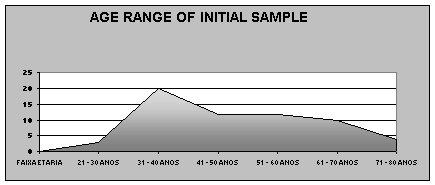
Figure 1.
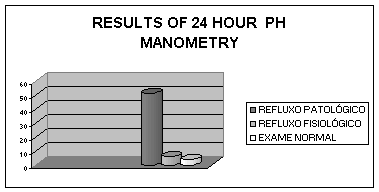
Figure 2.
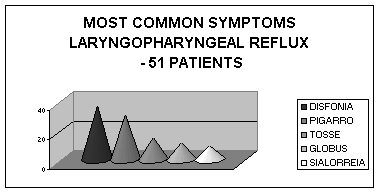
Figure 3.
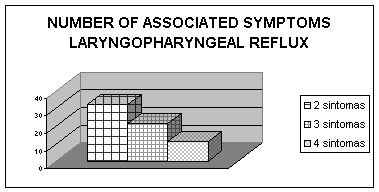
Figure 4.
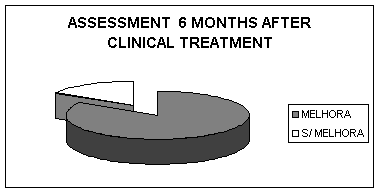
Figure 5.
The findings of the current study suggest that a solid case history associated with laryngoscopy findings that are indicative of laryngopharyngeal reflux have a great chance of being correlated to pathological changes in the pHmetry (83.6%). Nevertheless, laryngoscopy could not establish severity of the reflux, an issue identified by some other authors in their studiespapers 13.
Since EGD (esophagogastroduodenoscopy) is not an examination that is sensitive to laryngopharyngeal reflux, the method chosen was direct comparison between laryngeal telescopy together with 2-channel 24-hour pHmetry and manometry. This fact was corroborated by the high correlation percentage found (83.6%). In clinical practice, the initial request of EGD would be worthwhile due to its lower cost2,3,13.
Another important piece of data from this sample was the detection of certain symptoms associated with laryngopharyngeal reflux, namely; dysphonia (72.5%), throat clearing (60.8%), cough (29.4%), "globus" (23.5%) and sialorrhea (19.6%). Additionally, approximately 62.7% of the patients reported more than three associated symptoms proving once more the importance of the anamnesis in order to raise clinical suspicion 18,10,12.
The proper diagnosis of gastroesophageal reflux with laryngeal effects demand specific therapy,8, 19. According to recent studies, the practice of healthy dietary habits combined with the use of proton channel blocker drugs presented high level of initial therapeutic success. The patients in the study presented significant improvement of symptoms (83.7%), which is in accordance with some studies that were already published6,8,22,23, with highlights to Bauman's findings 2. The eight patients (16.3%) that did not respond to initial clinical therapy would be reassessed again in three months, and the increase of drug dosage or association with other drugs, as well as the surgery indication, should be analyzed.
The knowledge about laryngopharyngeal reflux has been evolving, from diagnosis to treatment. Today it is known that there are changes detected by histological examination that are not detected by endoscopy and 24-hour pHmetry. There are authors that question the need for more sophisticated examinations to manage gastroesophageal reflux and prefer the empiric use of drugs as therapeutic test and as management tool 7,10,12. The transposition of these therapies for laryngopharyngeal reflux have not been consolidated yet, however, if the proper means to conduct a comprehensive investigation are not available the doctor may choose to initiate the treatment 19.
More complex studies with higher number of samples and preferably with control groups will provide more reliable results. Still, it is licit to assume that patients without otorhinolaryngological findings other than laryngeal changes such as hyperemia and/or edema of arytenoids, epiglottis and hypopharynx, thickening of interarytenoidal space, or even vocal fold hyperemia and/or edema or thickening at endoscopy, with complaints of dysphonia, throat clearing, cough, "globus" sensation or sialorrhea of chronic nature should be subject to a more accurate investigation due to the association of those factors with gastroesophageal reflux disease.
6. CONCLUSION: There is an estimate that approximately less than half of the patients with ear, nose and throat symptoms of gastroesophageal reflux 1,16 are subjected to proper diagnostic investigation through esophageal pH manometry with two or three sensors, whether for cost saving or unsuspected diagnostic issues.
The patient clinical history associated with laryngoscopy, and preferably with stroboscopy, demand proper investigation if they reveal findings that suggest reflux after the doctor discards the chances of infections, nasosinusal, hypothyroidism diseases and smoking27. Laryngoscopy has gained more objective parameters to assess the level of hyperemia, edema and injury of the glottic and supraglottic structures. It becomes more significant with the attempt to use it as a management tool for initial diagnosis and follow-up of the responses to clinical or surgical therapy already established, in addition to controlling the laryngopharyngeal reflux even when 24-hour pHmetry and manometry are not available. The correct diagnosis can improve the patient's quality of life and prevent complications that are even more damaging to the already sick body, whether benign 17,18 or malignant5,9. For this reason, it is important to have a multidisciplinary approach with gastroenterologists, dietitians and psychologists.
The lack of knowledge about the disease made the investigation of this pathology to be many times classified as a psychological disorder. Today it can be diagnosed, followed up and treated. This study confirms the findings of the international literature,12,16,20,27,28, however it still requires an increased number of samples and the use of more complex epidemiological studies, be them population or experiment-oriented trials.
7- ACKNOWLEDGEMENT: We would like to thank all the team from the Head, Neck and Otorhinolaryngology Services of Hospital Santa Isabel and from the Otorhinolaryngology Institute Otaviano Andrade.
We would like to thank specially Dr. Helen Brum, a gastroenterologist that really helped us to conduct this study.
8- REFERENCES1- Ahuja V ; Yencha MW; Lassen LF. Head and neck manifestations of gastroesophageal reflux disease. Am Fam Physician, 199 Sep, 60:3, 873-80, 885-6
2- Bauman NM; Bishop WP; Sandler AD; Smith RJ. Value of pH probe testing in pediatric patients with extraesophageal manifestations of gastroesophageal reflux disease: a retrospective review. Ann Otol Rhinol Laryngol Suppl; 184: 18-24, 2000 Oct.
3- Belafsky PC; Postman GN; Koufman JA. Laryngopharyngeal reflux symptoms improve before changes in physical findings. Laryngoscope; 111(6): 979-81, 2001 Jun.
4- Biacabe B; Gleich LL; Lanccourreye O; Hartl DM; Bouchoucha M; Brasnu D. Silent gastroesophageal reflux disease in patients with pharyngolaryngeal cancer: further results. Head Neck, 1998 Sep, 20:6, 510-4.
5- Chen RJ; Ott DJ; Casolo BJ; Moghazy KM; Koufman Ja. Correlation of laryngeal and pharyngeal carcinomas and 24-hour pH monitoring of esophagus and pharynx. Otolaryngol Head Neck Surg, 1998 Nov, 119:5, 460-2.
6- Cote DN; Miller RH. The association of gastroesophageal reflux and otolaryngologic disorders. Compr Ther, 1995, 21:2, 80-4.
7- Fass R. Empirical trials in treatment of gastroesophageal reflux disease. Dig Dis; 18(1): 20-6,2000.
8- Forrest LA; Weed H. Candida laryngitis appearing as leukoplakia and GERD. J. Voice; 12(1):91-5, 1998 Mar.
9- Freije JE; Beatty TW; Campbell BH; Woodson BT; Schultz CJ; Toohill RJ. Carcinoma of the larynx in patients with gastroesophageal reflux. Am J Otolaryngol; 17(6):386-90, 1996 Nov-Dec.
10- Galmiche. Treat or investigate? Eur J Gastroenterol Hepatol; 11 Suppl 1: S11-5, 1999 Jun.
11- Gaynor EB . Laryngeal complications of GERD. J. Clin Gastroenterol; 30(3 Suppl):S31- 4, 2000 Apr.
12- Gerson LB; Robbins AS; Garber A; Homberg J; Triadafilopoulos G. A cost-effectiveness analysis of prescribing strategies in the management of gastroesophageal reflux disease. Am J Gastroenterol; 95(2):395-407, 200 Feb.
13- Haggitt RC. Department of Anatomic Pathology. Histopathology of reflux-induced esophageal and supraesophageal injuries. Am J Med; 108 Suppl 4a:109S-111S, 2000 Mar 6.
14- Hawkins BL. Laryngopharyngeal reflux: a modern day "great masquerader". J Ky Med Assoc, 1997 Sep, 95:9, 379-85.
15- Klinkeberg Knol EC. Otolaryngologic manifestation of gastro-esophageal reflux disease. Scand Gastroenterol Suppl, 1998, 225, 24-8.
16- Kouffman JA: The Otolaryngologic Manifestations of Gastroesophageal Reflux Disease. Laryngoscope 101:(Supplement 53) 1-78, 1991.
17- Kuhn J; Toohill RJ; Ulualp SO; Kulpa J; Hofmann C; Arndorfer R; Shaker R. Pharyngeal acid reflux events in patients with vocal cords nodules. Laryngoscope, 1998 Aug, 108:8 Pt 1, 1146-9.
18- Little FB, Koufman JA, Kohut RJ, et al: Effect of Gastric Acid on Pathogenesis of Subglottic stenosis. Ann Otol Rhinol Laryngol 94:516-19, 1985.
19- Metz DC; Childs ML; Ruiz C; Weinsteis GS. Pilot study of the oral omeprazoleOmeprazole test for reflux laryngitis. Otolaryngol Head Neck Surg, 1997 Jan, 116:1, 41-6.
20- Richter JE. Extraesophageal presentations of gastroesophageal reflux disease. Semin Gastrointest Dis, 1997 Apr, 8:2, 75-89.
21- Richter JE; Hicks DM. Unresolved issues in gastroesophageal reflux-related ear, nose and throat problems. Am J Gatroenterol, 1997 Dec, 92:12, 2143-4.
22- Ross JA; Noordzji; Woo P. Voice disorders in patients with suspected laryngopharyngeal reflux disease. J. Voice, 1998 Mar, 12:1,84-8.
23- Shaw GY; Searl JP; Young JL; Miner PB. Subjective laryngoscopic and acoustic measurements of laryngeal reflux before and after treatment with omeprazoleOmeprazole. J Voice, 1996 Dec, 10:4, 410-8.
24 -Sivarao DV; Goyal RK. Functional anatomy and physiology of the upper esophageal sphincter. Am J Med, 2000 Mar, 108 Suppl 4a:, 27S-37S
25- Slim K; Bousquet J; Kwiatkowski F; Lescure G; Pezet D; Chipponi J. Quality of life before and after laparoscopic fundoplication. Am J Surg; 180(1): 41-5, 2000 Jul
26- Spechler SJ; Lee E; Ahnen D; Goyal RK; Hirano I; Ramirez F; Raufman JP; Sampliner R; Schnell T; Sontag S; Vlahcevic ZR; Young R; Wiliford W. Long-term outcome medical and surgical therapies for gastroesophageal reflux disease: follow-up of a randomized controlled trial. JAMA; 285 (18): 2331-8, 2001 May 9.
27- Suazo J; Facha MT; Valdovinos MA. Estudio de casos y controles de manifestaciones atipicas en la enfermedad por reflujo gastroesofagico. Case and control study of atypical manifestations in gastroesophageal reflux disease. Rev Invest Clin; 50(4):317-22, 1998 Jul-Aug.
28- Toohill RJ; Kuhn JC. Role of refluxed acid in pathogenesis of laryngeal disorders. Am J Med, 1997 Nov, 103:5A, 100s-106s.
29- Waring JP; Lacayo L; Hunter J; Katz E; Suwak B. Chronic cough and hoarseness in patients with severe gastroesophageal reflux disease. Diagnosis and response to therapy. Dig Dis Sci, 1995 May, 40:5, 1093-7.
30- Weiner GM; Batch AJ; Radford k. Dysphonia as an atypical presentation of gastroesophageal reflux. J. Laryngol Otol., 1995 Dec, 109:12, 1195-6.
31- Wo JM; Hunter JG; Warning JP. Dual channel ambulatory esophageal pH monitoring. A useful diagnostic tool? Dig Dis Sci, 1997 Nov, 42:11,2222-6.
32- Woo P; Noorzij P; Ross JA. Association of esophageal reflux and globus symptom: comparison of laryngoscopy and 24-hour pH manometry. Otolaryngol head Neck Surg,
* Assistant Professor of Otorhinolaryngology, Medical and Public Health School; Associate Professor of Residence in Otorhinolaryngology, Santa Casa da Misericórdia da Bahia.
** Head of the Service of Otorhinolaryngology, Santa Casa da Misericórdia da Bahia; Assistant Professor of Otorhinolaryngology, Medical and Public Health School.
*** Otorhinolaryngologist, Santa Casa da Misericórdia da Bahia
Study conducted by the Service of Otorhinolaryngology and Head and Neck, Santa Casa da Misericórdia da Bahia, Instituto de Otorrinolaringologia Otaviano Andrade (INOOA) - Hospital Santa Izabel, Salvador, Bahia, Brazil.
Address correspondence to: Praça Almeida Couto s/n, Hospital Santa Izabel, INOOA, CEP 40050-410, Salvador Bahia, Brazil. - Tel: 55 71 326-0006/0260, 55 71 242-0796; Fax: 55 71 241-2623
E-mail: inooa@terra.com.br / dgvarela@bol.com.br / omarambaia@borl.com.br
Preliminary data presented at 35o.Congresso Brasileiro de Otorrinolaringologia - October 2000 - Natal.


